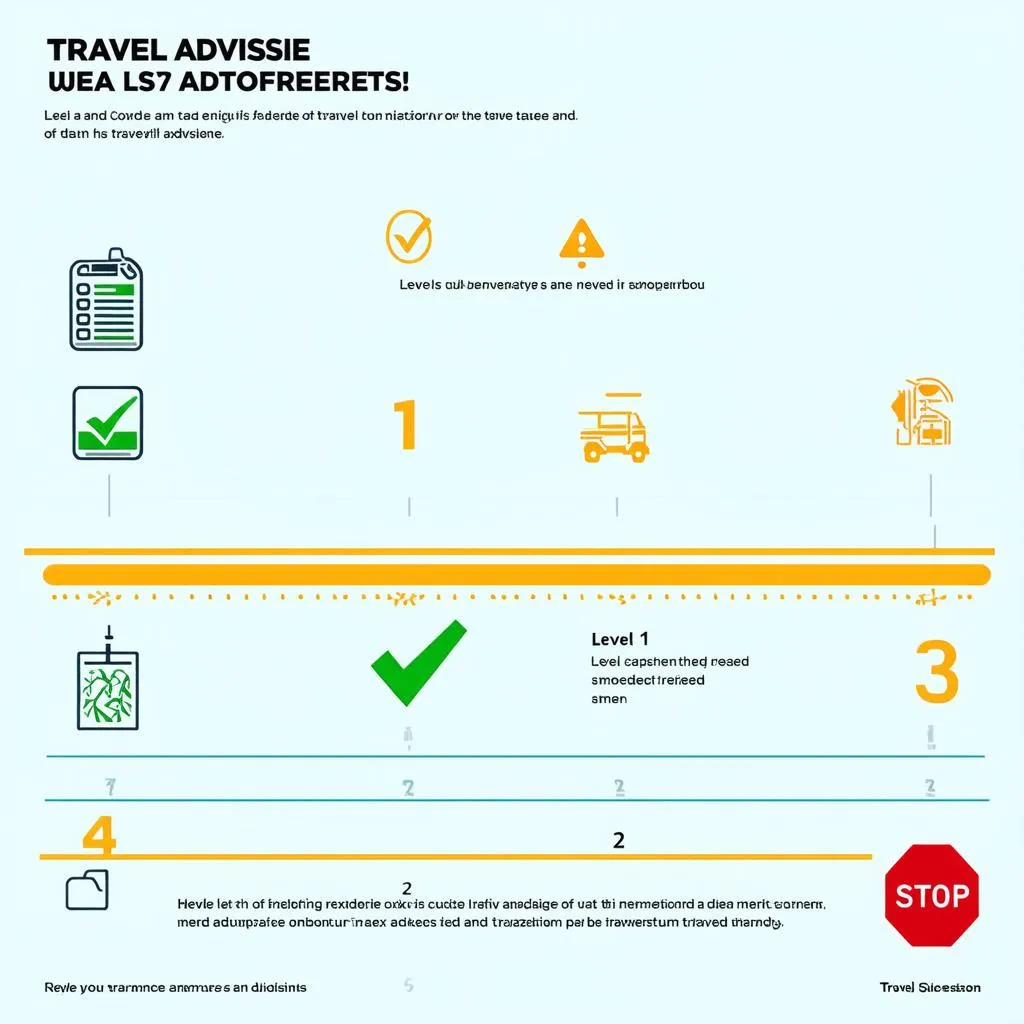Have you ever been excited about a trip, only to stumble upon a “travel advisory” for your destination? It’s like a little raincloud hovering over your sunny vacation plans. But what does it actually mean? Is it a gentle suggestion or a blaring siren to stay away? Don’t worry, we’re here to decode the mystery of travel advisories and empower you to make informed travel decisions.
Understanding the Language of Travel Advisories
In essence, a travel advisory is an official notice issued by a government (like the US Department of State) to provide information about the safety and security of traveling to a specific country or region. It’s their way of saying, “Hey, there might be some things you need to be aware of before you pack your bags.”
Think of it like a friend giving you a heads-up about a neighborhood. They might say, “It’s a lovely area, but watch out for pickpockets,” or “The roads are a bit rough in that part of town.” Similarly, travel advisories highlight potential risks and challenges you might encounter at your destination.
Why Are Travel Advisories Issued?
Travel advisories are issued for a variety of reasons, ranging from:
- Political instability or civil unrest: Imagine planning a relaxing getaway to a beautiful island only to find yourself caught in the middle of political protests. Travel advisories can alert you to such situations.
- Natural disasters: From hurricanes in the Caribbean to earthquakes in Japan, travel advisories keep you informed about potential natural disasters that could impact your trip.
- Health risks: Remember the Zika virus outbreak? Travel advisories often include information about disease outbreaks, required vaccinations, and health precautions.
- Crime rates: Just like some neighborhoods are safer than others, travel advisories can shed light on areas with higher crime rates or specific safety concerns for travelers.
Levels of Travel Advisories: From Exercise Normal Precautions to Do Not Travel
To make things easier to understand, travel advisories are often categorized into levels. While the specific systems may vary slightly between countries, here’s a general overview:
- Level 1: Exercise Normal Precautions: This is the most common level, indicating that while there might be some general risks, the destination is considered relatively safe for travelers who exercise common sense precautions. For example, a Level 1 advisory might be issued for a country experiencing petty theft in tourist areas.
- Level 2: Exercise Increased Caution: This level suggests that travelers should be extra vigilant due to heightened risks. This could be due to factors like increased crime rates, political tensions, or unpredictable weather conditions. A Level 2 advisory might be issued for a region experiencing civil unrest.
- Level 3: Reconsider Travel: This level signifies that serious risks are present, and travelers should seriously reconsider their need to travel to the destination. This could be due to ongoing armed conflict, a natural disaster aftermath, or a severe health crisis.
- Level 4: Do Not Travel: This is the highest level of advisory, urging citizens to avoid all travel to the specified destination due to extreme and imminent dangers. This could be issued for war-torn countries, regions experiencing widespread violence, or areas facing a catastrophic natural disaster.
 Travel Advisory Levels
Travel Advisory Levels
How to Find and Interpret Travel Advisories
Before you embark on your next adventure, it’s wise to check for any travel advisories issued for your destination. Here’s how:
- Government Websites: Most countries have dedicated government websites that provide travel information and advisories for their citizens. For example, US citizens can refer to the US Department of State’s website, while UK citizens can consult the UK Foreign, Commonwealth & Development Office’s website.
- Travel Apps: Several travel apps, such as Smart Traveler (US) or TravelSafe (Canada), provide up-to-date travel advisories, safety tips, and even allow you to register your trip with your embassy.
When reviewing a travel advisory, pay close attention to:
- The specific regions or areas affected: A travel advisory might apply to an entire country or just certain regions. For example, a country might have a Level 1 advisory overall but a Level 3 advisory for a specific region experiencing political unrest.
- The reasons behind the advisory: Understanding the reasons behind the advisory helps you assess the level of risk and make informed decisions.
- The recommendations provided: Travel advisories often include specific recommendations, such as avoiding certain areas, registering with your embassy, or taking extra precautions with your belongings.
Should You Cancel Your Trip Because of a Travel Advisory?
The decision to travel ultimately rests with you. A travel advisory is not a travel ban; it’s a piece of advice to help you make informed decisions.
“Travel advisories should be viewed as valuable tools, not trip-killers,” says travel expert, Sarah Jones, author of “Adventure Smart: Navigating the World with Savvy.” “They provide essential information that can empower travelers to make smart choices and have safe and enjoyable journeys.”
Here are some factors to consider:
- Your personal risk tolerance: Are you comfortable traveling to a destination with a certain level of risk, or do you prefer extremely safe and predictable environments?
- The purpose of your trip: A business trip to a major city with a Level 2 advisory might be more manageable than a backpacking adventure through remote villages in the same country.
- Your travel insurance coverage: Check if your travel insurance covers events related to the advisory, such as cancellations or medical emergencies.
 Travel Insurance Policy
Travel Insurance Policy
Tips for Traveling Safely to Destinations with Travel Advisories
If you decide to travel to a destination with a travel advisory, here are some essential tips to enhance your safety:
- Stay informed: Monitor the situation closely and be prepared to change your plans if necessary.
- Register your trip: Registering your trip with your embassy or consulate allows them to contact you in case of an emergency and provide assistance.
- Share your itinerary: Keep family or friends updated on your whereabouts and provide them with a copy of your itinerary.
- Be aware of your surroundings: Pay attention to your surroundings, especially in crowded areas or unfamiliar territories.
- Avoid risky behavior: Avoid activities that might put you at risk, such as walking alone at night in unfamiliar areas or engaging in illegal activities.
- Pack appropriately: Pack a first-aid kit, any necessary medications, and copies of important documents (passport, visa, insurance).
- Learn basic local phrases: Knowing a few basic phrases in the local language can be helpful, especially in emergencies.
Travelcar.edu.vn: Your Partner in Informed Travel
At Travelcar.edu.vn, we’re passionate about helping you navigate the world of travel safely and responsibly. Check out our website for more travel tips, destination guides, and insights to plan your next adventure. We believe that knowledge is power, and by staying informed, you can embrace the world with confidence and curiosity.
Have you ever traveled to a destination with a travel advisory? Share your experiences and insights in the comments below!